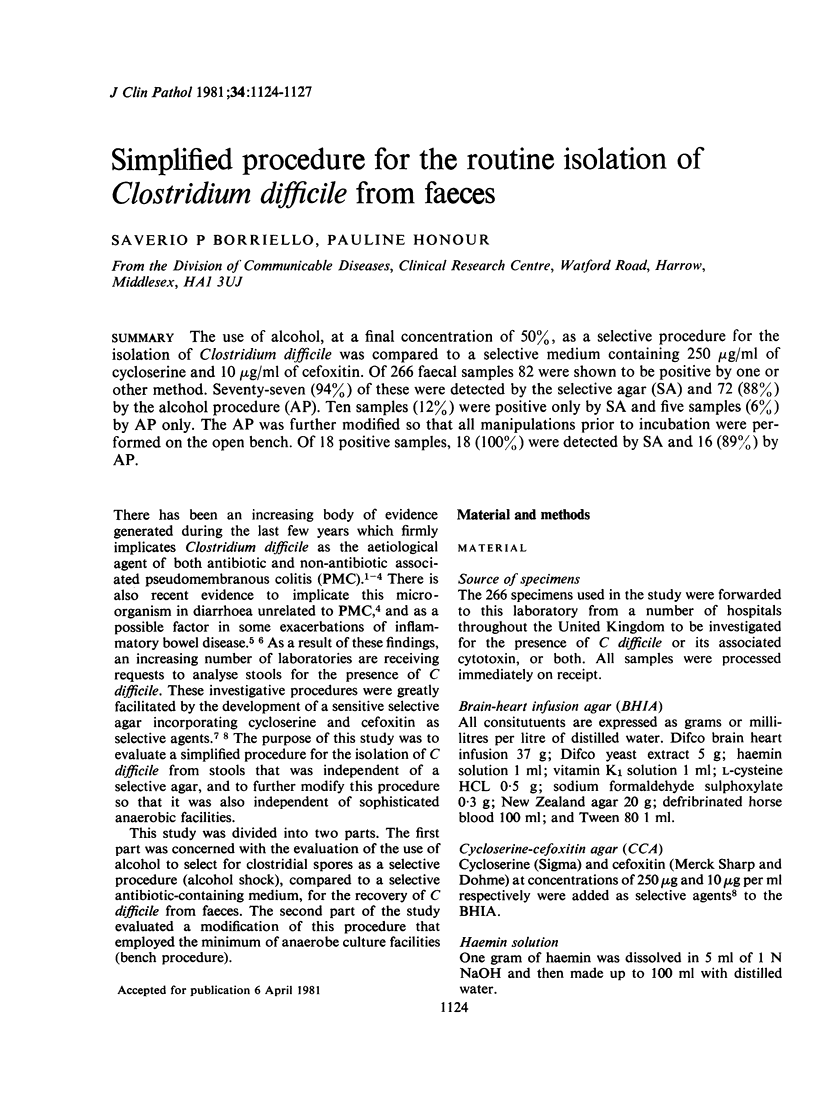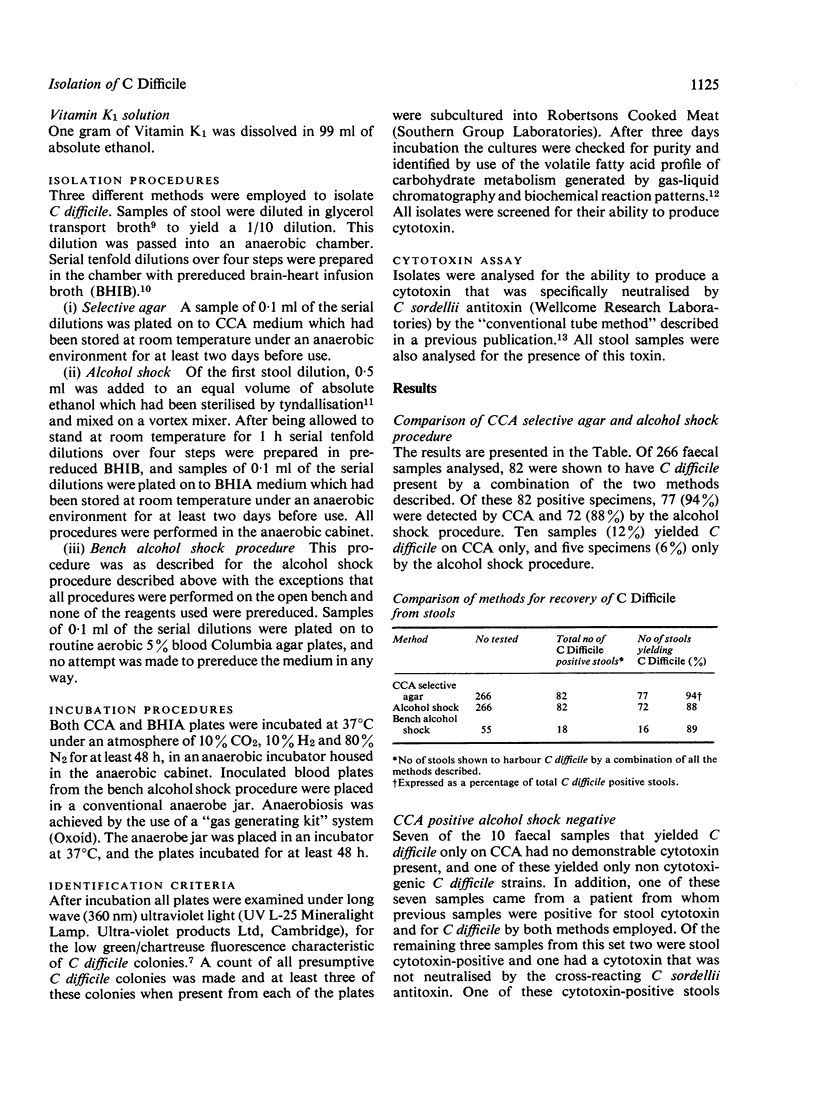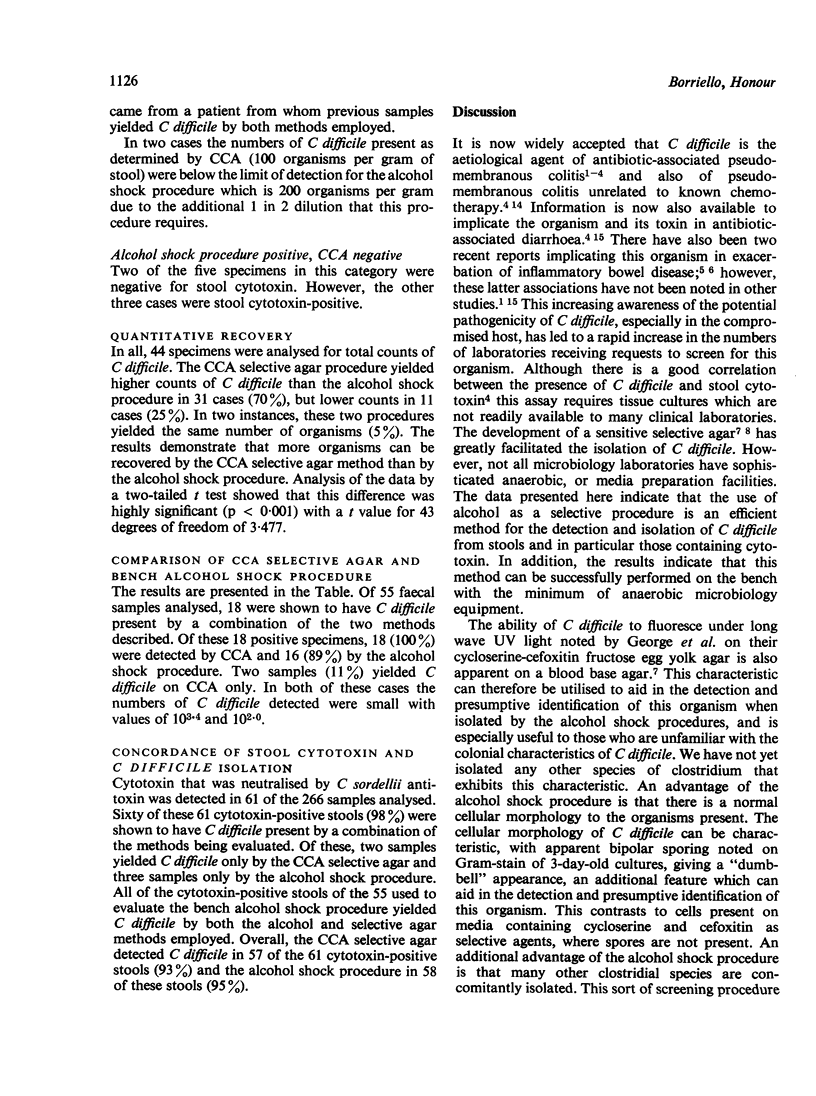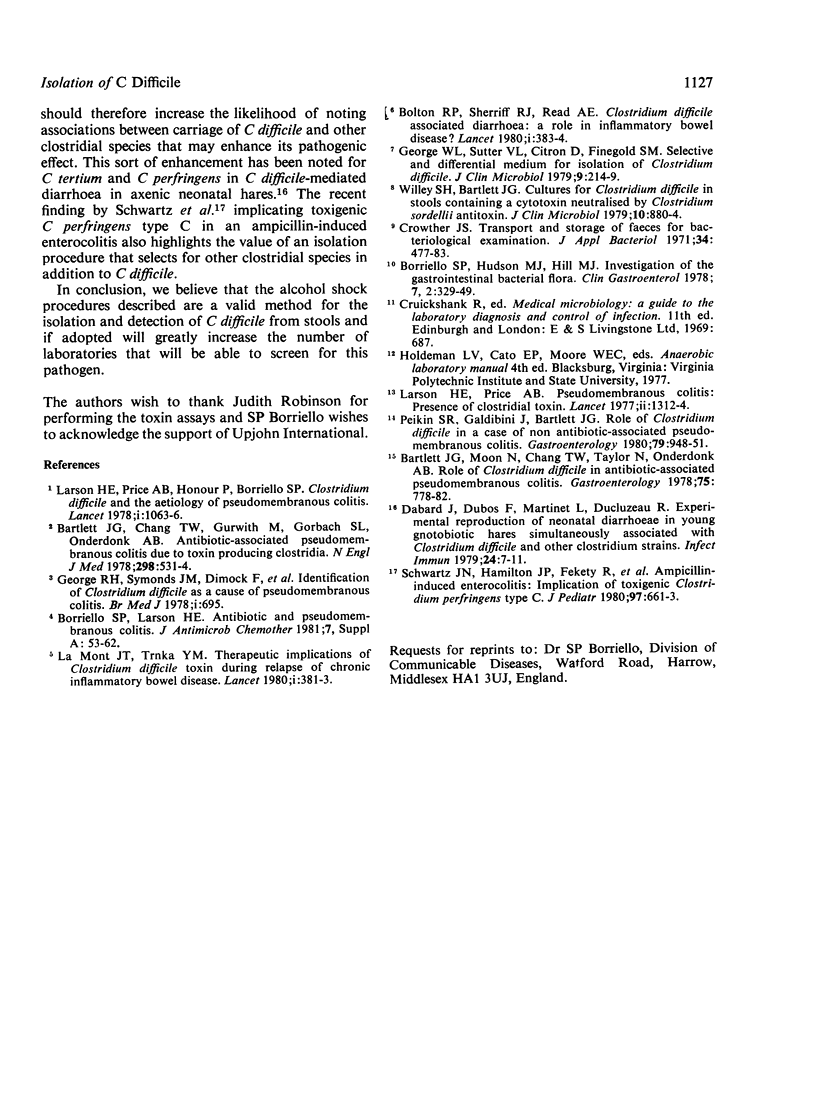Abstract
The use of alcohol, at a final concentration of 50%, as a selective procedure for the isolation of Clostridium difficile was compared to a selective medium containing 250 microgram /ml of cycloserine and 10 microgram /ml of cefoxitin. Of 266 faecal samples 82 were shown to be positive by one or other method. Seventy-seven (94%) of these were detected by the selective agar (SA) and 72 (88%) by the alcohol procedure (AP). Ten samples (12%) were positive only by SA and five samples (6%) by AP only. The AP was further modified so that all manipulations prior to incubation were performed on the open bench. Of 18 positive samples, 18 (100%) were detected by SA and 16 (89%) by AP.
Full text
PDF



Selected References
These references are in PubMed. This may not be the complete list of references from this article.
- Bartlett J. G., Chang T. W., Gurwith M., Gorbach S. L., Onderdonk A. B. Antibiotic-associated pseudomembranous colitis due to toxin-producing clostridia. N Engl J Med. 1978 Mar 9;298(10):531–534. doi: 10.1056/NEJM197803092981003. [DOI] [PubMed] [Google Scholar]
- Bartlett J. G., Moon N., Chang T. W., Taylor N., Onderdonk A. B. Role of Clostridium difficile in antibiotic-associated pseudomembranous colitis. Gastroenterology. 1978 Nov;75(5):778–782. [PubMed] [Google Scholar]
- Bolton R. P., Sherriff R. J., Read A. E. Clostridium difficile associated diarrhoea: a role in inflammatory bowel disease? Lancet. 1980 Feb 23;1(8165):383–384. doi: 10.1016/s0140-6736(80)90940-x. [DOI] [PubMed] [Google Scholar]
- Borriello P., Hudson M., Hill M. Investigation of the gastrointestinal bacterial flora. Clin Gastroenterol. 1978 May;7(2):329–349. [PubMed] [Google Scholar]
- Crowther J. S. Transport and storage of faeces for bacteriological examination. J Appl Bacteriol. 1971 Jun;34(2):477–483. doi: 10.1111/j.1365-2672.1971.tb02307.x. [DOI] [PubMed] [Google Scholar]
- Dabard J., Dubos F., Martinet L., Ducluzeau R. Experimental reproduction of neonatal diarrhea in young gnotobiotic hares simultaneously associated with Clostridium difficile and other Clostridium strains. Infect Immun. 1979 Apr;24(1):7–11. doi: 10.1128/iai.24.1.7-11.1979. [DOI] [PMC free article] [PubMed] [Google Scholar]
- George R. H., Symonds J. M., Dimock F., Brown J. D., Arabi Y., Shinagawa N., Keighley M. R., Alexander-Williams J., Burdon D. W. Identification of Clostridium difficile as a cause of pseudomembranous colitis. Br Med J. 1978 Mar 18;1(6114):695–695. doi: 10.1136/bmj.1.6114.695. [DOI] [PMC free article] [PubMed] [Google Scholar]
- George W. L., Sutter V. L., Citron D., Finegold S. M. Selective and differential medium for isolation of Clostridium difficile. J Clin Microbiol. 1979 Feb;9(2):214–219. doi: 10.1128/jcm.9.2.214-219.1979. [DOI] [PMC free article] [PubMed] [Google Scholar]
- LaMont J. T., Trnka Y. M. Therapeutic implications of Clostridium difficile toxin during relapse of chronic inflammatory bowel disease. Lancet. 1980 Feb 23;1(8165):381–383. doi: 10.1016/s0140-6736(80)90939-3. [DOI] [PubMed] [Google Scholar]
- Larson H. E., Price A. B., Honour P., Borriello S. P. Clostridium difficile and the aetiology of pseudomembranous colitis. Lancet. 1978 May 20;1(8073):1063–1066. doi: 10.1016/s0140-6736(78)90912-1. [DOI] [PubMed] [Google Scholar]
- Larson H. E., Price A. B., Honour P., Borriello S. P. Clostridium difficile and the aetiology of pseudomembranous colitis. Lancet. 1978 May 20;1(8073):1063–1066. doi: 10.1016/s0140-6736(78)90912-1. [DOI] [PubMed] [Google Scholar]
- Larson H. E., Price A. B. Pseudomembranous colitis: Presence of clostridial toxin. Lancet. 1977 Dec 24;2(8052-8053):1312–1314. doi: 10.1016/s0140-6736(77)90363-4. [DOI] [PubMed] [Google Scholar]
- Peikin S. R., Galdibini J., Bartlett J. G. Role of Clostridium difficile in a case of nonantibiotic-associated pseudomembranous colitis. Gastroenterology. 1980 Nov;79(5 Pt 1):948–951. [PubMed] [Google Scholar]
- Schwartz J. N., Hamilton J. P., Fekety R., Green E. G., Stamper L., Batts D. H., Silva J. Ampicillin-induced enterocolitis: implication of toxigenic Clostridium perfringens type C. J Pediatr. 1980 Oct;97(4):661–663. doi: 10.1016/s0022-3476(80)80037-0. [DOI] [PubMed] [Google Scholar]
- Willey S. H., Bartlett J. G. Cultures for Clostridium difficile in stools containing a cytotoxin neutralized by Clostridium sordellii antitoxin. J Clin Microbiol. 1979 Dec;10(6):880–884. doi: 10.1128/jcm.10.6.880-884.1979. [DOI] [PMC free article] [PubMed] [Google Scholar]


